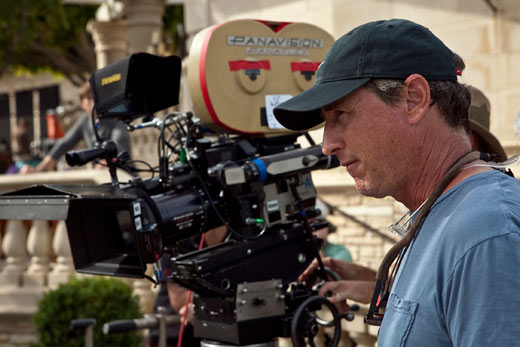It's All About the Eyelines
For Hop, Hill and Collister shot Super 35 film but exposed the full four-perf frame in order to provide room for repositioning in post. “Sometimes the animators can enhance the physical comedy or adjust eyelines by moving elements within the frame,” says Collister. “Sometimes you want the bunny’s ear to flop up, for instance. Shooting four-perf gave us that flexibility.”
The cameras and lenses were Panavision, and the film stock was KODAK VISION3 500T Color Negative Film 5219.

Peter Lyons Collister
Collister and Hill had already considered digital on the previous projects Garfield: A Tail of Two Kitties and Alvin & the Chipmunks but opted for film. “Basically, because of our positive experiences on Garfield 2 and Alvin, the assumption was that we would shoot film on Hop,” says Collister. “While we were prepping Alvin, the studio [Fox] put up some pretty severe budget restrictions. Tim and I said ‘If someone can show us how we can save $300,000 to $500,000 by shooting digital, we’ll entertain the idea.’ Nobody, including some big-name camera manufacturers, was able to show us any real savings at all. Rhythm & Hues, which is our visual effects and compositing house on these projects, prefers film.
“I’ve done a couple projects on digital formats, but to me, film is the best acquisition medium. I’ve done tests that showed that digital cameras can have impressive resolution, but not nearly the dynamic range of 35mm film. It’s the most effective way to convey a story.”
Collister and his visual-effects collaborators at Rhythm & Hues “lit” the rabbit with more moodiness than might be expected for a comedy meant for a young audience. “We are always looking at how well the character integrates into the scene,” says Collister. “We have found that if you do flat lighting within a movie that has CGI characters, they tend to look less convincingly photoreal than if the lighting is a bit moodier or darker.
“Rhythm & Hues provided us with images in which each layer of the image is separately controllable,” says Collister. “We could change the colors on one CG character without affecting anything else, and without the need to painstakingly draw a window around an element and track it. That saved us weeks of time, and meant countless compromises were avoided.”
Digital intermediate timing gives the filmmakers another opportunity to blend CG and live-action elements to complete the illusion. Collister’s regular digital colorist is David Cole at LaserPacific in Hollywood.
“The challenge in this type of film is always making the CG characters fit into the scene in a realistic way,” says Cole. “Over the course of several projects, we have closed the loop in terms of color science with Peter, Tim, LaserPacific and Rhythm & Hues, so that everyone is seeing the same images. Shooting on 35mm brings a lot of range and flexibility into the post process.
“The new Kodak DI film [VISION3 2254/5254 Color Intermediate], LaserPacific color science, and Deluxe’s precise lab work all contribute to making the digital and film prints match exactly,” says Cole. “Anything that makes the characters more believable and integrate smoother is a good thing. The goal is to make the audience forget that there are two different worlds – CG and live action – and just go along with the flow of the story.”
Did you enjoy this article? Sign up to receive the StudioDaily Fix eletter containing the latest stories, including news, videos, interviews, reviews and more.








